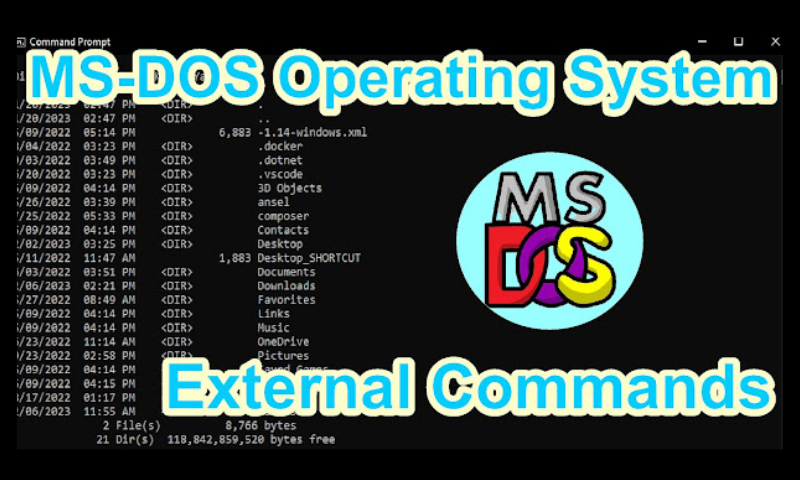In this post, we discuss on External Commands of the MS-DOS Operating System step-by-step.
We’ll discuss and cover the above topic: Vist my “MS-DOS Operating System Playlist” videos on our YouTube channel.
Let’s get started!
External Commands
External commands in MS-DOS are commands that are not built into the operating system and are typically stored in separate executable files. These commands can perform various functions, including file management, system management, and data management.
External Commands with Examples and Syntax
Here are some of the most commonly used external commands in MS-DOS, along with their syntax and examples:
Format Command
The “format” command is a common external command in MS-DOS that is used to format a disk for use with MS-DOS. The format command can be used to format floppy disks, hard disks, and other removable media. The syntax for the format command is as follows:
FORMAT drive: [/V[:label]] [/Q] [/F:size] [/C] [/X]
where:
drive: is the letter assigned to the drive you want to format (e.g., A, B, C, etc.).
/V[:label] is an optional switch that allows you to specify a volume label for the disk. The label can be up to 11 characters long and must not contain any spaces.
/Q is an optional switch that performs a quick format. This switch skips the check for bad sectors and is faster than a regular format, but may result in less reliable disks.
/F:size is an optional switch that allows you to specify the size of the disk to be formatted. The size can be either 360K, 720K, 1.2M, 1.44M, 2.88M, or larger for hard disks.
/C is an optional switch that allows you to format multiple diskettes by automatically requesting you to insert new diskettes as needed.
/X is an optional switch that forces the format command to dismount the drive if it is in use, which allows you to format the disk even if files are still open.
Example:
FORMAT C: /V:MYDISK /Q
This example formats the C: drive, assigns the volume label “MYDISK” to the disk, and performs a quick format.
Xcopy Command
The “xcopy” command is a commonly used external command in MS-DOS that is used to copy files and directories from one location to another. The xcopy command is more advanced than the basic “copy” command, as it allows you to copy entire directories, subdirectories, and all their contents, in addition to individual files. The syntax for the xcopy command is as follows:
XCOPY source destination [/A | /M] [/D[:date]] [/P] [/S]
[/E] [/V] [/W]
where: Source is the location of the files or directories you want to copy.
Destination is the location where you want to copy the files or directories.
/A is an optional switch that allows you to copy only those files with the archive attribute set.
/M is an optional switch that allows you to copy only those files with the archive attribute set and then reset the archive attribute.
/D[:date] is an optional switch that allows you to copy only those files that have been modified on or after the specified date.
/P is an optional switch that prompts you to confirm that you want to overwrite an existing file.
/S is an optional switch that allows you to copy subdirectories and files.
/E is an optional switch that allows you to copy directories and subdirectories, including empty ones.
/V is an optional switch that verifies the copy operation by comparing the source and destination files after they have been copied.
/W is an optional switch that causes the xcopy command to wait for you to insert a disk when the disk becomes full during the copy operation.
Example:
XCOPY C:data D:backup /S /E /V
This example copies all files and subdirectories from the C:data directory to the D:backup directory, including empty directories, and verifies the copy operation by comparing the source and destination files after they have been copied.
Sort Command
The “sort” command is an external command in MS-DOS that is used to sort the contents of a text file. The sort command reads the contents of a file and sorts its lines in a specified order, such as alphabetically or numerically, and then outputs the sorted contents to the screen or to another file.
The syntax for the sort command is as follows:
SORT [/R] [/+n] [/M n] [drive:][path]filename
where:
/R is an optional switch that sorts the lines in reverse order.
/+n is an optional switch that specifies the starting character position for the sort.
/M n is an optional switch that specifies the maximum number of characters to sort on.
[drive:][path]filename is the location of the file you want to sort.
Example:
SORT C:datanames.txt /R > C:sortednames.txt
This example sorts the contents of the file C:datanames.txt in reverse order and outputs the sorted contents to a file
named C:sortednames.txt.
Find Command
The “find” command is an external command in MS-DOS that is used to search for a specified string of text within one or more files. The find command searches through the contents of a file, line by line, and outputs any lines that contain the specified text.
The syntax for the find command is as follows:
FIND [/V] “string” [drive:][path]filename
where:
/V is an optional switch that reverses the search and returns lines that do not contain the specified string.
“string” is the text string you want to search for.
[drive:][path]filename is the location of the file or files you want to search.
Example:
FIND “John” C:datanames.txt
This example searches for the string “John” within the file C:datanames.txt and outputs any lines that contain the string.
CHKDSK
(Check Disk) Command
The “chkdsk” command is an external command in MS-DOS that is used to check the integrity of a disk and repair any errors it finds. The chkdsk command scans the disk and identifies any bad sectors, lost clusters, and other disk errors. If errors are found, chkdsk attempts to repair them.
The syntax for the chkdsk command is as follows:
CHKDSK [drive:] [/F] [/V]
where:
[drive:] is the drive you want to check (for example,
“C:”).
/F is an optional switch that causes chkdsk to fix any errors it finds.
/V is an optional switch that displays the name of each file as it is checked.
Example:
CHKDSK C: /F /V
This example checks the disk in drive “C:” for errors and attempts to fix any errors it finds. The names of each file as it is
checked will be displayed on the screen.
Move Command
The “MOVE” external command in MS-DOS is used to move one or more files from one directory to another or to rename a file or directory.
Syntax:
MOVE [source] [destination]
Example:
MOVE C:old_folderfile.txt C:new_folderfile.txt
In this example, the file “file.txt” is moved from the “old_folder” directory to the “new_folder” directory. If a file with the same name already exists in the destination folder, it will be overwritten. The source and destination parameters can also be used to specify different drive letters.
It’s important to note that the MOVE command can only be used to move files within a single file system, so it cannot be used to move files between a floppy disk and a hard drive.
Diskcopy Command
The “DISKCOPY” external command in MS-DOS is used to copy the contents of one floppy disk to another floppy disk. It is a disk cloning utility that creates an exact copy of a disk, including all data and system files.
Syntax:
DISKCOPY [source_disk] [destination_disk]
Example:
DISKCOPY A: A:
In this example, the contents of the floppy disk in drive A: are copied to another floppy disk in drive A:. The source and destination disks must be the same type of disk, such as both being 5.25-inch or 3.5-inch floppy disks.
It’s important to note that DISKCOPY can only be used to copy floppy disks and cannot be used to copy hard drives or other types of storage media. Also, since the command is designed for floppy disks, it does not provide any error correction or data compression features.


.jpg)
.jpg)


